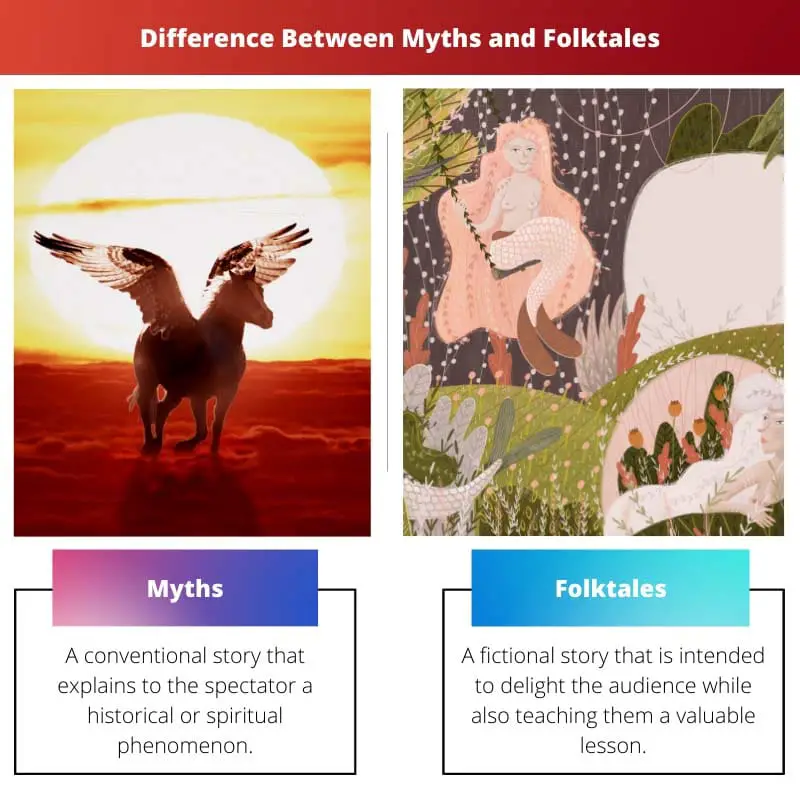The distinction between myth and folktale is very sleek, almost razor-thin. Myths and folktales, on the other hand, are fiction categories in any society.
As they display their lives, religious convictions, and rituals, as well as their imaginative power of people, they are indicative of the culture and traditions of a group. So, despite the similarities in their genres, there are some points of distinction between them.
Key Takeaways
- Myths are traditional stories that explain natural phenomena, religious beliefs, or cultural practices.
- Folktales are stories passed down through generations, including fables, legends, and fairy tales.
- Both forms of storytelling preserve cultural heritage and teach moral lessons, but myths have a stronger connection to religious and supernatural beliefs.
Myths vs Folktales
A myth is a legendary tale that explains a phenomenon relating to historical facts and events. It is a symbolic story that features demi-gods, deities and supernatural beings. Folklore is a fictitious story passed on through generations by ordinary people. It features animals and magical creatures.

A myth is a powerful symbolic story based on a tradition or religious belief. Its original word means ‘story.’ Even if it does not necessarily recount a true event, a myth transmits a truth about the universe or humans to its audience.
As a result, in a myth, the significance of the narrative’s events is more significant than the happenings themselves.
A folktale is a story that has been passed down orally through the ages. Folktales are stories or tales told by ordinary folks. Therefore, they are passed on from our ancestors to us and expected to continue the same way through the ages.
Folktales are stories that are for the delight of the audience while simultaneously teaching them a lesson about their morality and societal ethics. Folktales from various civilizations are diverse and unique.
Comparison Table
| Parameters of Comparison | Myths | Folktales |
|---|---|---|
| Meaning | A conventional story that explains to the spectator a historical or spiritual phenomenon. | A fictional story that is intended to delight the audience while also teaching them a valuable lesson. |
| Passed on by | Typically passed down through religious scholars and priests. | Passed from ordinary people. |
| Characters | Generally spiritual and religious beings such as deities, demi-gods, and otherworldly creatures. | Characters are mostly regular folk, beasts, and occasionally magical creatures. |
| Importance | Myths frequently teach morals and convey a religious or spiritual message. | Mostly provide pleasure, but they can also convey a valuable life lesson. |
| Example | Legends of Adam and Eve, Thor, Hercules, Icarus, Odin, Achilles. | Aladdin, Hansel, and Gretel, The Three Little Pigs, The Pied Piper. |
What are Myths?
A myth is a strongly symbolic story based on culture or religious convictions.’ Even if it does not necessarily recount a true event, a myth transmits facts about the universe or humans to its audience.
As a result, myth explains the origins of the world, natural occurrences such as birth and death, and human situations such as pain and faults, among other things.
The origin of these tales is unknown, even though we know that they can be traced back to the classical era. They have been passed down orally through the ages as a part of our tradition.
They also employ terms like sorrow, victory, integrity, courage, fairness, and even folly.
These tales talk about figures like gods, deities, demi-gods, magical beings, and even people and animals and make them the main characters of its stories.
As a result, myths have a religious significance, being the tales that highlight a set of religious conventions, beliefs and behaviours.
Although the event or incident to which a myth refers is not actual, certain myths may have been significantly influenced by true events, which have been changed to become more symbolic over time or in different regions.
These tales have their own significance to people like any other.

What are Folktales?
These are stories that have been passed down orally through the ages. As a result, this kind of tale is “people’s knowledge passed down through the generations by oral (the most common form), written, and visual means at any point in history.
Folktale is defined by Merriam-Webster as “an anonymous, timeless, and placeless tale shared orally among people.
Folktales, on the other hand, are stories or tales told by ordinary people. Besides entertainment, these also teach the audience a lesson about behavioural and social morals and ethics.
As a result, various civilizations have their own distinct and unique folktales. As a result, it can be said that a folktale is a direct embodiment of the ideals and behavioural practices of a culture.
Folktales are more secular than myths, which are connected to religious rituals and traditions. Animal stories are among the most ancient of all folktales. They are a mix of myth, folklore, and fairy tales.
Early myths and folklore include them prominently. Many European folktales feature talking animals. The most well-known traditional folktales are wonder tales (also known as fairy tales).
They are magical marvel stories that show the struggle between good and evil. The majority of stories end with virtue triumphing and happy marriage.

Main Differences Between Myths and Folktales
- A myth is a conventional story that explains to the spectator a historical or spiritual phenomenon. On the other hand, the folktale is a fictional story that is intended to delight the audience while also teaching them a valuable lesson.
- Myths are passed down through religious scholars and priests, whereas folktales are passed from ordinary people.
- Figures in myths are spiritual and religious beings such as deities, demi-gods, and otherworldly organisms, while those in folklore are mostly regular folk, beasts, and occasionally magical creatures.
- Myths frequently teach morals; as a result, they convey a religious or spiritual message. Folktales provide pleasure, but they can also portray a valuable life lesson.
- The examples of myths vary from those of folktales. Legends of Adam and Eve, Thor, Hercules, Icarus, Odin, Achilles, and others are examples of the former. Aladdin, Hansel and Gretel, The Three Little Pigs and the Beanstalk, and The Seven Ravens are some examples of the latter.


While the article is informative, I believe it could have included more examples of myths and folktales from different cultures to provide a more comprehensive understanding of the subject.
The article’s emphasis on the origins and transmission of myths and folktales is commendable, but I also see the value in incorporating a wider range of cultural examples to enrich the discussion.
I agree with your point, Harvey. Including diverse examples of myths and folktales would have made the article even more insightful and engaging.
While the article provides valuable insights into myths and folktales, the absence of a more critical analysis of their societal impact and contemporary relevance leaves an opportunity for further exploration.
This discussion on myths and folktales is indeed thought-provoking as it delves into the cultural and spiritual aspects of these traditional narratives. The emphasis on the characters and significance of myths is particularly intriguing.
The comparison table outlining the differences between myths and folktales is a great visual aid that effectively highlights the key distinctions between these two forms of storytelling.
I found the comparison table to be a valuable addition to the article, presenting a clear and concise summary of the disparities between myths and folktales.
I couldn’t agree more, Lexi. The comparison table serves as a useful reference point for understanding the unique attributes of myths and folktales.
The detailed exploration of myths and folktales, accompanied by a clear differentiation of their characteristics, underscores the rich cultural and literary significance of these traditional stories.
I agree, Mwalsh. The article adeptly elucidates the enduring appeal and cultural importance of myths and folktales, contributing to a deeper appreciation of these narratives.
The detailed explanations of myths and folktales, along with the historical and cultural contexts, provide a captivating exploration of these traditional narratives.
I share your sentiment, Jsimpson. The article effectively captures the essence of myths and folktales, shedding light on their significance and cultural implications.
The article articulates the distinctions between myths and folktales with scholarly precision, offering a comprehensive understanding of these timeless narratives.
This article provides an in-depth analysis of the differences between myths and folktales, shedding light on their significance and cultural implications. The comprehensive comparison table is quite informative and helps to clarify the distinctions between the two forms of storytelling.
I completely agree, Justine. The article effectively captures the essence of myths and folktales, making it easier for readers to understand the nuances of these traditional stories.
I found the explanations of myths and folktales to be very enlightening. The detailed analysis of the characters, transmission, and significance of these stories adds great value to the content.